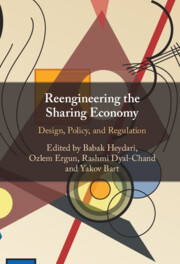Refine search
Actions for selected content:
2860 results in Computing and Society
13 - Future Themes in the Sharing Economy
- from Part II-B - Applications of Tomorrow
-
-
- Book:
- Reengineering the Sharing Economy
- Published online:
- 30 March 2023
- Print publication:
- 06 April 2023, pp 228-246
-
- Chapter
-
- You have access
- Open access
- HTML
- Export citation
Part I - Cross-Cutting Foundations and Norms for the Sharing Economy of Tomorrow
-
- Book:
- Reengineering the Sharing Economy
- Published online:
- 30 March 2023
- Print publication:
- 06 April 2023, pp 11-114
-
- Chapter
-
- You have access
- Open access
- HTML
- Export citation

Reengineering the Sharing Economy
- Design, Policy, and Regulation
-
- Published online:
- 30 March 2023
- Print publication:
- 06 April 2023
-
- Book
-
- You have access
- Open access
- Export citation
4 - Clouds of Smoke
- from Part II - Who Are the Choice-Makers?
-
- Book:
- Unwired
- Published online:
- 29 April 2023
- Print publication:
- 28 March 2023, pp 47-61
-
- Chapter
- Export citation
1 - Becoming the Choice-Makers
- from Part I - The Price of the Illusion of Control
-
- Book:
- Unwired
- Published online:
- 29 April 2023
- Print publication:
- 28 March 2023, pp 3-15
-
- Chapter
- Export citation
7 - Lessons from Battling Titans
- from Part II - Who Are the Choice-Makers?
-
- Book:
- Unwired
- Published online:
- 29 April 2023
- Print publication:
- 28 March 2023, pp 95-106
-
- Chapter
- Export citation
2 - Addiction, Our Children, Our Bonds
- from Part I - The Price of the Illusion of Control
-
- Book:
- Unwired
- Published online:
- 29 April 2023
- Print publication:
- 28 March 2023, pp 16-32
-
- Chapter
- Export citation
11 - The Achilles Heel
- from Part III - Fighting for Choice
-
- Book:
- Unwired
- Published online:
- 29 April 2023
- Print publication:
- 28 March 2023, pp 148-163
-
- Chapter
- Export citation
3 - Invisible Chains
- from Part I - The Price of the Illusion of Control
-
- Book:
- Unwired
- Published online:
- 29 April 2023
- Print publication:
- 28 March 2023, pp 33-44
-
- Chapter
- Export citation
Copyright page
-
- Book:
- Unwired
- Published online:
- 29 April 2023
- Print publication:
- 28 March 2023, pp iv-iv
-
- Chapter
- Export citation
Contents
-
- Book:
- Unwired
- Published online:
- 29 April 2023
- Print publication:
- 28 March 2023, pp vii-viii
-
- Chapter
- Export citation
Dedication
-
- Book:
- Unwired
- Published online:
- 29 April 2023
- Print publication:
- 28 March 2023, pp v-vi
-
- Chapter
- Export citation
Part II - Who Are the Choice-Makers?
-
- Book:
- Unwired
- Published online:
- 29 April 2023
- Print publication:
- 28 March 2023, pp 45-106
-
- Chapter
- Export citation
8 - The Art of Redesign
- from Part III - Fighting for Choice
-
- Book:
- Unwired
- Published online:
- 29 April 2023
- Print publication:
- 28 March 2023, pp 109-122
-
- Chapter
- Export citation
Epilogue
-
- Book:
- Unwired
- Published online:
- 29 April 2023
- Print publication:
- 28 March 2023, pp 177-179
-
- Chapter
- Export citation
Acknowledgments
-
- Book:
- Unwired
- Published online:
- 29 April 2023
- Print publication:
- 28 March 2023, pp 180-182
-
- Chapter
- Export citation
Part III - Fighting for Choice
-
- Book:
- Unwired
- Published online:
- 29 April 2023
- Print publication:
- 28 March 2023, pp 107-176
-
- Chapter
- Export citation
Prologue
-
- Book:
- Unwired
- Published online:
- 29 April 2023
- Print publication:
- 28 March 2023, pp ix-xiv
-
- Chapter
- Export citation
Part I - The Price of the Illusion of Control
-
- Book:
- Unwired
- Published online:
- 29 April 2023
- Print publication:
- 28 March 2023, pp 1-44
-
- Chapter
- Export citation
Index
-
- Book:
- Unwired
- Published online:
- 29 April 2023
- Print publication:
- 28 March 2023, pp 225-234
-
- Chapter
- Export citation
